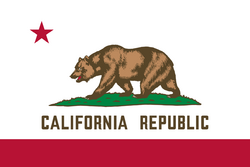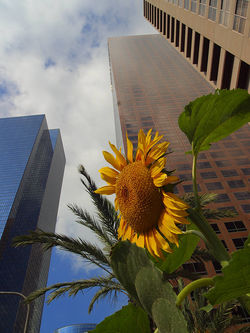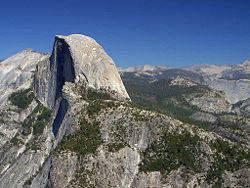California (U.S. state)
California is a U.S. state located on the west coast of the North American continent. With nearly 40 million residents across a total area of approximately 163,696 square miles, it is the most populous U.S. state and the third-largest by area. It is also the most populated subnational entity in North America and the 34th most populous in the world. The Greater Los Angeles and San Francisco Bay areas are the nation's second and fifth most populous urban regions, respectively, with the former having more than 18.7 million residents and the latter having over 9.6 million. Sacramento is the state's capital, while Los Angeles is the most populous city in the state. San Francisco, California is the second most densely populated major city in the country. California borders Oregon to the north, Nevada, and Arizona to the east, the Mexican state of Baja California to the south; and has a coastline along the Pacific Ocean to the west. "Silicon Valley" is the informal name of the technology-focused region centered on San Jose, south of San Francisco. As of 2020, more than 10% of the population of the United States lives in California.
History
- See also: California, history to 1845 and California, history since 1846
The first Europeans to explore the coast of California were the members of a Spanish expedition led by Portuguese captain Juan Rodríguez Cabrillo in 1542. Cabrillo was commissioned by Antonio de Mendoza, the Viceroy of New Spain, to lead an expedition up the Pacific coast in search of trade opportunities; they entered San Diego Bay on September 28, 1542, and reached at least as far north as San Miguel Island.
The Portolá expedition of 1769–1770 was a pivotal event in the Spanish colonization of California, resulting in the establishment of numerous missions, presidios, and pueblos. The military and civil contingent of the expedition was led by Gaspar de Portolá, who traveled over land from Sonora into California, while the religious component was headed by Father Junípero Serra, who came by sea from Baja California. In 1769, Portolá and Serra established Mission San Diego de Alcalá and the Presidio of San Diego, the first religious and military settlements founded by the Spanish in California.
After the Portolà expedition, Spanish missionaries led by Father Serra set out to establish 21 Spanish missions of California along what much later became the El Camino Real ("The Royal Road"), 16 sites of which were chosen during the Portolá expedition. Numerous major cities in California grew out of missions, including San Diego, Ventura, Santa Barbara, and San Francisco.
The Spaniards gave the name Las Californias to the peninsula of Baja California. As Spanish explorers and settlers moved north and inland, the region known as California, or Las Californias, grew. Eventually it included lands north of the peninsula, Alta California, part of which became the present-day U.S. state of California.
The name California most likely derived from the mythical island of California in the fictional story of Queen Calafia, as recorded in a 1510 work Las Sergas de Esplandián (The Adventures of Esplandián) by Garci Rodríguez de Montalvo. Queen Calafia's kingdom was said to be a remote land rich in gold and pearls, inhabited by beautiful Black women who wore gold armor and lived like Amazons, as well as griffins and other strange beasts.
The United States captured California in 1846 as part of the Mexican War; it paid compensation to Mexico, which now owned the land after a war with Spain, through the the Treaty of Guadalupe Hidalgo of 1848.
In January 1848, gold was discovered at Sutter's Mill in the Sierra Nevada foothills about 40 miles east of Sacramento, beginning the California Gold Rush, which had the most extensive impact on population growth of the state of any era.
The miners and merchants settled in towns along what is now State Highway 49, and settlements sprang up along the Siskiyou Trail as gold was discovered elsewhere in California. The nearest deep-water seaport was San Francisco Bay, and San Francisco, California became the home for bankers who financed exploration for gold.
The Gold Rush brought the world to California. By 1855, some 300,000 "Forty-Niners" had arrived from every continent; many left after a year or so—some rich, most not very rich. A precipitous drop in the Native American population occurred in the decade after the discovery of gold.
In 1847–1849 California was run by the U.S. military; local government continued to be run by alcaldes (mayors) in most places; but now some were Americans. Bennett Riley, the last military governor, called a constitutional convention to meet in Monterey in September 1849. Its 48 delegates were mostly pre-1846 American settlers. They unanimously outlawed slavery and set up a state government that operated for 10 months before California was given official statehood by Congress on September 9, 1850, as part of the Compromise of 1850. A series of small towns were used briefly as the state capital until finally Sacramento was selected in 1854.
Politics
The current Governor of California is Gavin Newsom, a Democrat and the 40th governor. Jerry Brown, also a Democrat, was the 39th governor. The state generally votes for Democratic candidates for president, has a liberal Democratic majority in the legislature and congressional delegation. San Francisco, California is a major liberal bastion, while Los Angeles is a major factor in political fundraising for national politicians of all stripes.
Economy
California’s economy is the largest of any U.S. state and surpassed by only by a handful of industrialized countries. As of 2022, the state had a gross state product of greater than $3.5 trillion, the largest of any non-national state in the world. With the development of Silicon Valley in the late 1970s, California became a world leader in the manufacture of computers and electronics. By the end of the 20th century, the state’s economy was attracting highly educated workers from all over the world. Moreover, California has retained its dominance in the aerospace industry (though the industry declined in the 1990s), in the film and television industry, and in agriculture. California's film industry retains its long-held place as the most dominant in the world, including long-standing film studios in Southern California and newcomers, such as Pixar in Northern California. California is the most important center in the United States for growing many vegetables and fruit crops, including lettuce, citrus and other fruits, table and wine grapes, and tree nuts, such as almonds. Rice is an important crop in northern California, and cotton remains an important crop in the inland valley. Dairy farming is a major industry.
Agriculture
In the Los Angeles area the San Gabriel Mountains' alluvial fans in the foothills and valleys were ideal for citrus cultivation, which had a steady, high-value national market. Citrus growers needed laborers and discovered American farmers were not interested in hired labor with no chance of ownership. Therefore the growers, questing for a kind of peasantry, brought in ethnic minorities. Sikh, Chinese, Japanese, and Filipino laborers came in the late 19th century, but they too wanted to be owners. After 1900 the growers turned to Mexican immigrants as the primary work force. Large numbers were available from nearby Mexico; they worked hard and were more interested in their community lives than in ownership. Mexicans therefore supplanted other ethnic groups throughout most of California. By the 1920s, some 150,000 to 200,000 Mexicans comprised the bulk of the citrus labor force.[1]
Education
California is the home of several major research universities and top liberal arts colleges. Prominent private institutions of higher education include Stanford University, California Institute of Technology, Claremont McKenna College, Pomona College, and University of Southern California. The University of California system operates numerous public universities, most well-known ones being UC Berkeley and UCLA.
In the "Smartest States" ranking by Morgan Quitno Press, California ranks the 47th among the 50 states in the United States in 2006-2007.[2]
Geography
Climate
Historic Points of Interest

A view of Mission San Juan Capistrano in April of 2005. The Mission has earned a reputation as the "Loveliest of the Franciscan Ruins."
See also
Notes
- ↑ See García (2001).
- ↑ 2006-2007 Smartest State Award, Morgan Quitno Press.


